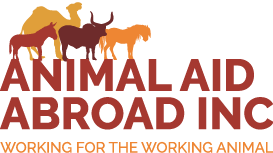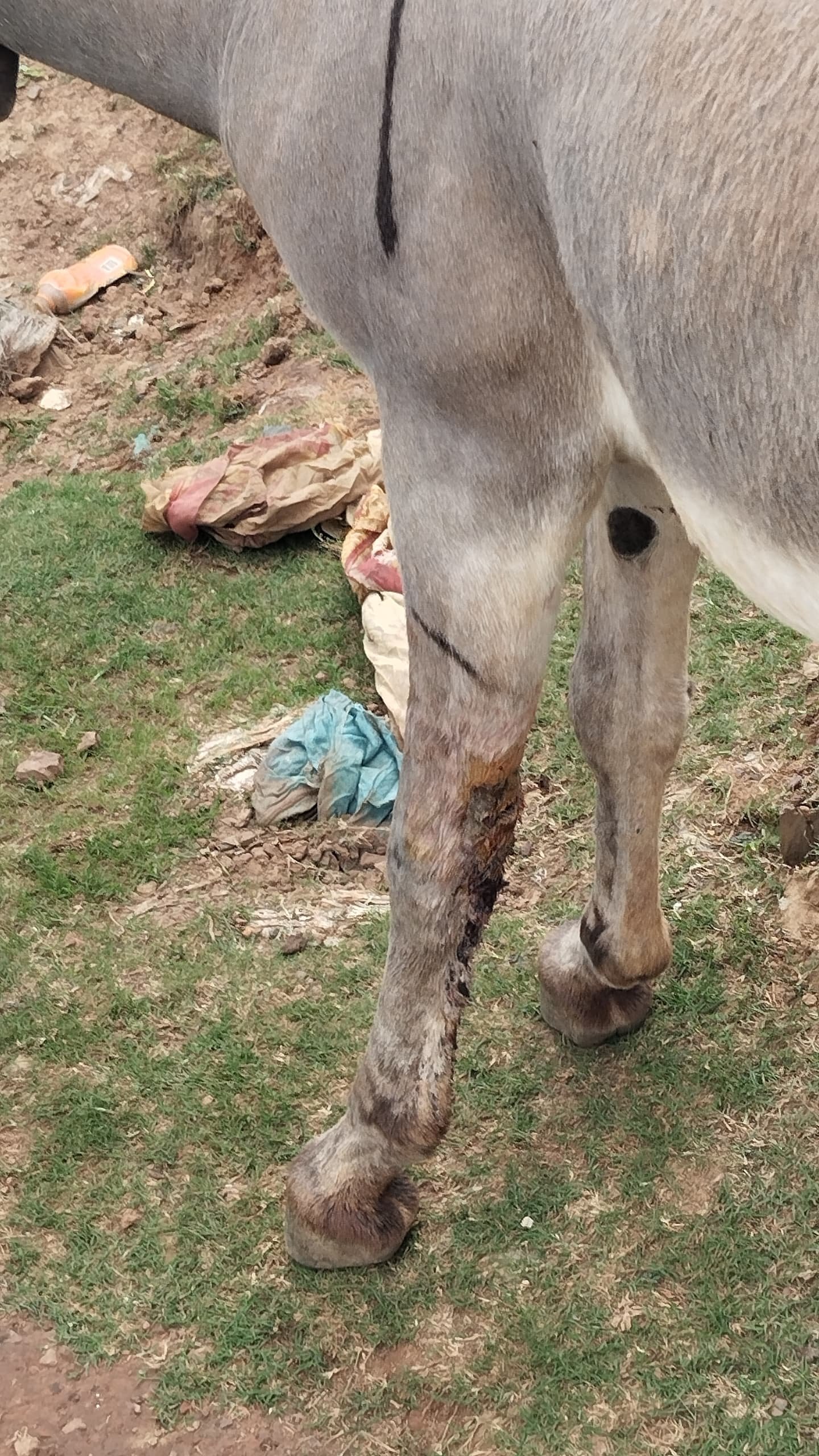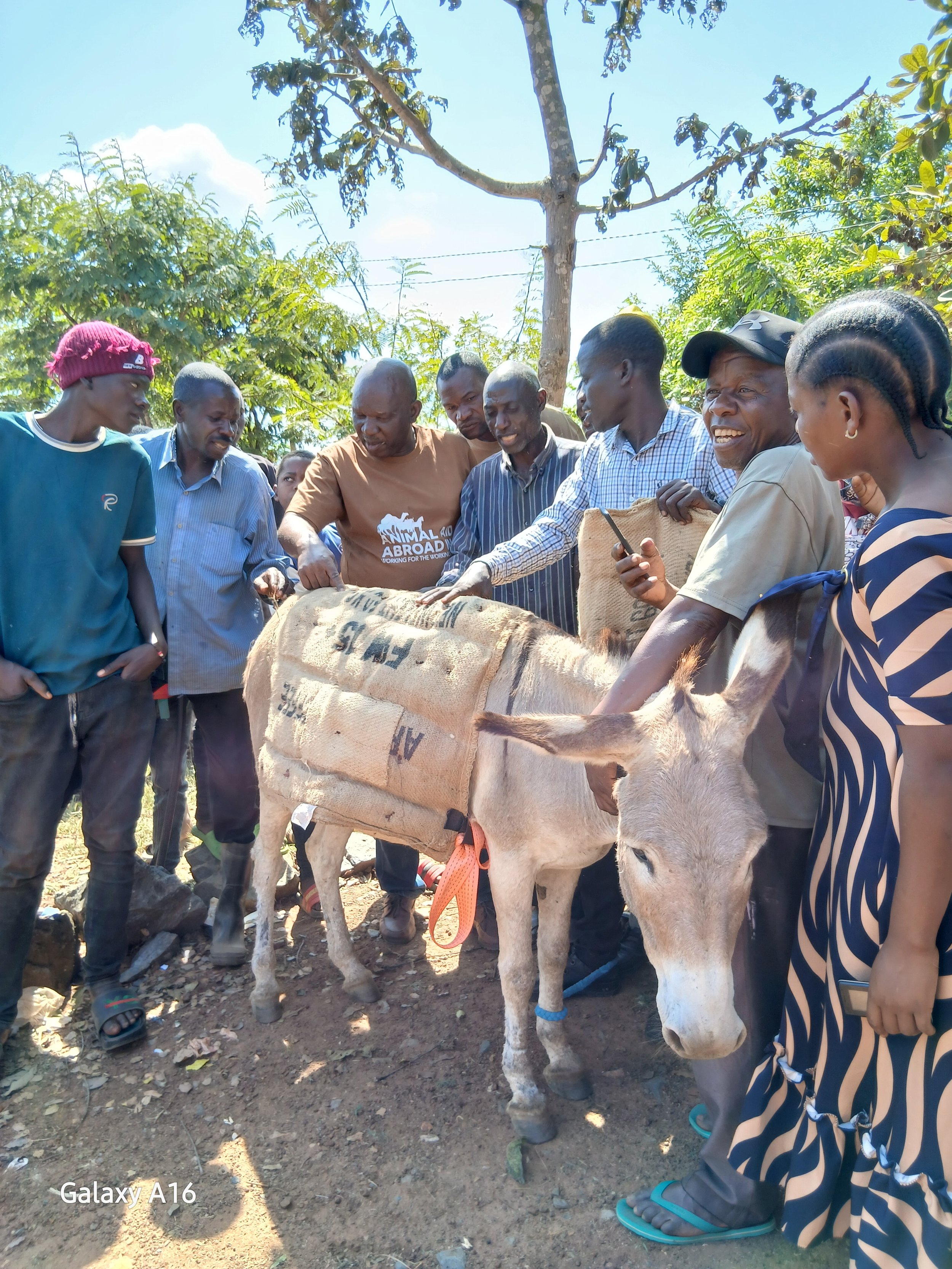Providing Essential Care for Gold Mine Donkeys in Geita
Due to your stellar support and compassion, Lake Zone Animal Welfare Organization (LAZAWO) are continuing to make great strides towards helping donkeys working in the gold mines of Geita. Please read on for their full report from May:
1.0 Introduction
Working donkeys are indispensable to the daily operations of gold mining communities in Geita District, Tanzania, especially for transporting gold ore, water, and other loads, but despite this essential role, they often face harsh conditions marked by poor husbandry, extreme workloads, and limited access to veterinary services, in which many suffer from wounds, parasitic infections, musculoskeletal injuries, and chronic exhaustion which compromise both their welfare and the livelihoods of the communities that depend on them.
In response to these challenges, a field-based veterinary health service by LAZAWO team in May 2025 preceded by services in previous months was instituted targeting on clinical care, preventive services, and owner education across six mining sites of Lwamgasa, Nyarugusu, Nyaruyeye, Mgusu, Magenge, and Stamico, prioritising treatment of common ailments, management of complex cases including fractures and blindness, routine deworming, and monitoring of donkeys newly arriving from local auctions.
2.0 Veterinary Activities
A total of 463 working donkeys received veterinary attention during this month. Where additional to clinical work, the program emphasised capacity building through practical training and collaboration with local authorities, including the Geita Regional and Geita District offices. In the following sections are the key activities, outcomes, and impact of the May 2025 veterinary activities, highlighting the ongoing efforts to improve animal welfare and strengthen the economic resilience of donkey-dependent households in Geita mining zones.
3.0 Follow-Ups
3.1 Follow-Up Testimony of Rafiki's Full Recovery
Rafiki, the calm and dependable donkey of the Nyaruyeye mining site, has made a remarkable recovery following the severe injury to his right hind leg, after sustaining a fracture while transporting heavy loads, initially his condition deteriorated due to the use of traditional treatment methods and rudimentary splinting, which led to infection.
Following intervention by Leocardia and LAZAWO veterinary team, the traditional materials were carefully removed, the infected site was thoroughly cleaned and disinfected, and proper immobilization of the leg was done using standardised techniques.
Today, Rafiki is fully recovered, and bearing weight comfortably on the previously fractured leg and has resumed his work duties gradually, under light loads. The gait is steady, and the owner has expressed deep gratitude for the support, proper fracture care and the importance of early veterinary intervention. Rafiki’s recovery stands as a testimony to the impact of timely and professional care in improving the welfare of working donkeys.
3.2 Follow-Up of a Donkey with Hind Leg Slash Wounds in Mgusu
A donkey suffered two deep slash wounds on the hind leg in an incident that went unreported for several days, who was later spotted doing field rounds during our field visits in Mgusu. Upon examination, the wounds were cleaned thoroughly and treated with antiseptics. Despite the delayed reporting, the donkey is now showing steady improvement. Follow-up visits confirm progressive healing, with reduced swelling, formation of healthy granulation tissue, and improved comfort while walking. The case emphasises the need for timely reporting and regular monitoring of working donkeys.
4.0 Training and Outreach
As part of our ongoing commitment to improve the welfare of working donkeys in Geita, LAZAWO veterinary team targeted outreach and training sessions in Lwamgasa and Nyaruyeye communities, with a specific focus on humane handling and the use of appropriate saddling techniques. A comprehensive hands-on training was provided on the proper fitting, maintenance, and fabrication of saddles using locally available materials. The training aimed not only to distribute saddles but to empower owners with practical knowledge and skills to produce and repair saddles independently in the future. A total of 50 donkey owners directly received custom-designed saddles: 25 in Lwamgasa and 25 in Nyaruyeye.
In addition to organised sessions, routine field visits by Dr Kagaruki and Leokadia across all six major gold mines involved on-the-spot engagement with donkey handlers and donkey cart operators encountered along mining transport routes and key topics of these informal, yet impactful discussions included, humane working hours, emphasising rest periods and avoidance of peak heat times, proper feeding and hydration protocols to support donkey endurance and health, recognition and basic management of treatable wounds, with demonstrations where possible, introducing ourself as the local veterinary service providers, enhancing trust and building rapport.
4.1 Observed Impact on Training and Outreach
Donkey owners expressed genuine enthusiasm and appreciation upon learning that proper saddling could prevent wounds, reduce stress, and improve performance in their animals.
Many participants were inspired to experiment with self-making saddles, reflecting a shift toward ownership of animal welfare practices.
Continued awareness is expected to help in reduction of back sores and pressure wounds among donkeys, particularly in the two target communities.
4.2 Impact of Field-based Education
There was a marked reduction in the number of donkeys observed working during peak sun hours, reflecting increased awareness of heat stress and fatigue.
Donkey owners and handlers began proactively reporting clinical cases, seeking veterinary consultation and treatment for wounds, lameness, and general health issues.
A notable shift in attitude was observed from viewing donkeys as expendable assets to valued working partners requiring care and protection and these initiatives reflect a growing culture of compassionate handling and collaborative animal care within the mining communities, whereas the integration of direct training and spontaneous field interactions used as a model for sustainable behaviour change.
5.0 Case Studies
5.1 Acute Reversible Blindness in a Working Donkey Following a Fall into an Open Gold Mining Pit in Nyarugusu.
On Wednesday evening, May 21, 2025, a donkey owner in Nyarugusu village, Geita District, contacted our team (Dr Kagaruki) after his donkey reportedly fell into an open pit abandoned after gold extraction. Following removal from the pit, the owner noted that the donkey showed signs of blindness. Our team arrived on the next day for examination of that open pit and the donkey. Upon physical examination, the donkey was standing and alert but exhibiting disorientation, menace response and visual tracking reflexes were absent bilaterally, pupillary reflexes were present but delayed, and no external injuries, swelling, or ocular discharge were noted, there was no history of convulsions or loss of consciousness, reducing suspicion of cerebral trauma.
Diagnosis based on the clinical presentation suggested transient vision loss, possibly due to ocular chemical irritation from residual substances in the pit, or mechanical ocular trauma or pressure during the fall, or possible optic nerve concussion without structural damage, but due to limited diagnostic capacity in the field (no ophthalmoscope or imaging), a presumptive diagnosis of acute ocular irritation or trauma was made.
Treatment and management involved conservative and supportive management using normal saline irrigation where both eyes were flushed thoroughly with sterile normal saline for three consecutive days and the owner was advised to rest the animal and provide it enough feeds and water for seven days and no systemic antibiotics or anti-inflammatories were deemed necessary due to the absence of infection, inflammation, or systemic signs.
The animal’s full visual behaviour was restored and the owner reported that the donkey resumed work without difficulties. This indicated that such reversible vision loss in donkeys could have been due to exposure to mining residues or trauma but basic field veterinary care, rapid assessment and timely intervention, even with minimal tools, significantly saved the animal.
5.2 Successful Management of a Sharp Object-Induced Laceration on the Radius of a Working Donkey in Mgusu
A male working donkey from owner known as Simon in Mgusu presented with a laceration on the left forelimb at the medial lateral region of mid-radius. The injury was reported to have been caused by a sharp object, possibly a machete or metal scrap possibly due to trespassing crops, leading to partial detachment of skin and subcutaneous tissues which were observed hanging loosely from the wound margins.
Clinical findings found incised laceration with clean edges and tissue detachment. Moderate wound size (8–10 cm), ceased haemorrhage at time of examination, mild weight-bearing lameness.
Treatment and management involved immediate primary repair as the injury appeared recent and free from contamination, and therefore it included the following:
I. Physical Restraining with the assistance of three handlers to avoid the need for systemic sedation in the field.
II. Infiltration of 2% lidocaine hydrochloride around the wound margins to provide localised analgesia.
III. Shaved to minimise hair and facilitate a clean surgical field. The wound was flushed thoroughly with normal saline followed by diluted povidone iodine.
IV. The displaced skin was realigned and closed using silk 2-0 sutures in three pairs of simple interrupted sutures, ensuring good apposition and minimal tension.
V. Meloxicam (anti-inflammatory): 0.5 mg/kg IM once daily for 3 days Penicillin-Streptomycin (broad-spectrum antibiotic): 1 ml/20 kg IM once daily for 3 days
The donkey was monitored post surgery and wound healing progressed without signs of infection or dehiscence however full recovery from this injury is expected to be in early June. The owner was then advised to restrict workload and keep the donkey in a clean grazing environment and not in or around crop farms to prevent further cruelty to his donkeys.
5.3 Suspected Mercury Poisoning in a Working Donkey from a Mgusu Gold Mining site.
The owner reported that the donkey had been excessive drooling, appeared less responsive to visual cues, and showed slightly labored breathing. These signs developed suddenly within a day. The donkey is believed to have been grazed near shallow mercury wash pits for some days. As a veterinary team we arrived for examination and apparently there were No history of trauma, feed change, or known tick paralysis noted. Maybe the donkey was drinking from surface runoff near the mining area.
Differential diagnoses involved mercury poisoning (most likely) due to strong environmental exposure (common in gold amalgamation), signs of salivation, pyrexia, mild blindness, known water and soil contamination with elemental mercury in the area, other differentials included Organophosphate toxicity but no recent spraying observed or reported and absence of muscarinic signs such as bradycardia, and diarrhoea reduced the likelihood, possible tick paralysis (localised cranial form) due to neurotoxic saliva effects as some ticks were observed but absence of ascending paralysis, incoordination, or recumbency ruled it out, other conditions like rabies or viral encephalitis was ruled out due to stable mentation, normal feeding, and rapid resolution
In absence of laboratory diagnostics, treatment focused on symptomatic and supportive management of the following:
i. Fluid Therapy using normal saline (NS 500mls) IV and SC for two days
ii. Oxytetracycline 20% – 1 mL/10 kg IM to prevent secondary infections and cover tick-borne diseases
iii. Dexamethasone 1% – 0.05 mg/kg IM to reduce neuroinflammation and counteract oxidative damage
iv. Multivitamin injection 10 mL IM to support hepatic detoxification and nerve function
v. Tick removal by manual cleaning of ear base and perineal region
vi. Resting the animal and avoid water from contaminated wash sites
The animal fully recovered within three days of treatment as drooling stopped within 24 hours post initial treatment, currently the donkey has resumed its daily activities. This positive response to supportive care, even without specific chelation, reinforced the hypothesis of mild mercury toxicity with limited systemic accumulation and this case demonstrates the need for increased veterinary toxicovigilance in mining zones, improved community education on environmental toxicants, and development of mobile veterinary support for remote donkey populations.
5.4 Field Management of a Proximal Radius Fracture in a Working Donkey Mgusu
Nemla is a newly purchased working donkey, acquired from a local livestock auction and brought to Lwamgasa on May 25th. According to her owner, Mr Edward, she was introduced to a new environment and allowed to graze peacefully alongside other donkeys as they rested in preparation for work, however on the evening of May 27th, while rounding up the donkeys, Mr Edward noticed that Nemla could not place weight on her left forelimb and upon closer inspection, the leg appeared completely fractured suggesting a forceful impact, possibly from a heavy object by unknown individuals during chasing away from their land, as the grazing area is close to human settlements.
On our response to Mr Edward’s call for help, our clinical findings upon physical examination, noted the animal standing with extreme reluctance to move and left forelimb held in flexion, marked pain on palpation of the proximal region of the left radius, moderate localised swelling around the proximal radius, audible and palpable crepitus upon gentle manipulation and no external wounds, lacerations, or puncture marks were observed, ruling out an open fracture, the slightly increased cardinal parameters consistent with pain and stress
Due to the absence of on-site radiographic equipment, a presumptive diagnosis was made using clinical signs, physical manipulation, anatomical localisation and knowledge, and assessment of fracture instability, which clearly indicated a complete break rather than a fissure or greenstick fracture and thus a complete closed fracture of the proximal radius on left forelimb was diagnosed.
Treatment and immediate management involved the following steps:
I. Sedation and anaesthesia by premedication with Xylazine 2% (5 ml IV for estimated 130kg donkey) followed by Induction with Ketamine 5%: 10 ml IV) were Sedation achieved within 7 minutes followed by smooth induction to lateral recumbence for the procedure.
II. Reduction and immobilisation by manual closed reduction with axial traction and counter-pressure under sedation.
III. A protective dressing layer of sterile gauze was applied over the limb.
IV. Generous padding with cotton wool was wrapped from the distal humerus to below the carpus to prevent pressure necrosis and enhance cast stability.
V. A reinforcement layer of adhesive tape was added to secure the padding.
VI. Plaster of Paris (P.O.P.) cast was applied circumferentially from just below the elbow joint to below the carpal joint, ensuring coverage of the fracture site while avoiding immobilisation of the shoulder or distal limb joints.
Duration of the procedure was approximately 40 minutes and the donkey had a smooth and spontaneous recovery from anaesthesia.
Post procedure involved medicaments administration especially Meloxicam for counteracting inflammation and pain, Oxytetracycline 20% for secondary bacterial infection and resting donkey for rest fracture healing period to minimise limb use and cast damage.
Nemla’s prognosis remains fair, depending on long-term stabilisation, infection control, and nutritional support however closed radius fractures in adult donkeys are challenging due to weight-bearing stress. But this early intervention, Mr Edward’s compliance, and controlled rest will offer a good recovery chance, because Mr Edward has demonstrated commendable concern for his donkey’s wellbeing and has committed to following through with her care and recovery.
6.0 Challenges/Gaps
Difficulty in follow up cases as donkeys requiring close medical follow-up are either returned to work prematurely or left to roam unsupervised so that it is hard to locate them and his significantly complicates continuity of care and monitoring.
Lack of diagnostic equipments such as ophthalmoscopes and mouth gag/speculum, which makes it challenging to accurately assess conditions involving the eyes and oral cavity.
7.0 Conclusion
Veterinary activities in May 2025 stands as a testament to the resilience of working donkeys in Geita communities as these voiceless donkeys bear immense burdens daily hauling heavy loads under unforgiving conditions with quiet endurance Through this outreach, their suffering was not only acknowledged but addressed with compassion, skill and commitment.
Improvements in health, mobility, and comfort of 423 treated donkeys reflect the profound impact of targeted veterinary intervention, however beyond treatment, the engagement with owners and local authorities promises a long-term welfare change.
None of this would have been possible without the unwavering support of Animal Aid Abroad. Your compassionate, visionary and dedication towards helping these voiceless working animals not only brings hope and healing, but also dignity to donkeys who ask for nothing yet give everything. LAZAWO veterinary team are deeply grateful and feel truly honored to be part of a mission that brings light to the forgotten, suffering, and those once abandoned. Thank you for standing by the donkeys of Geita.
















